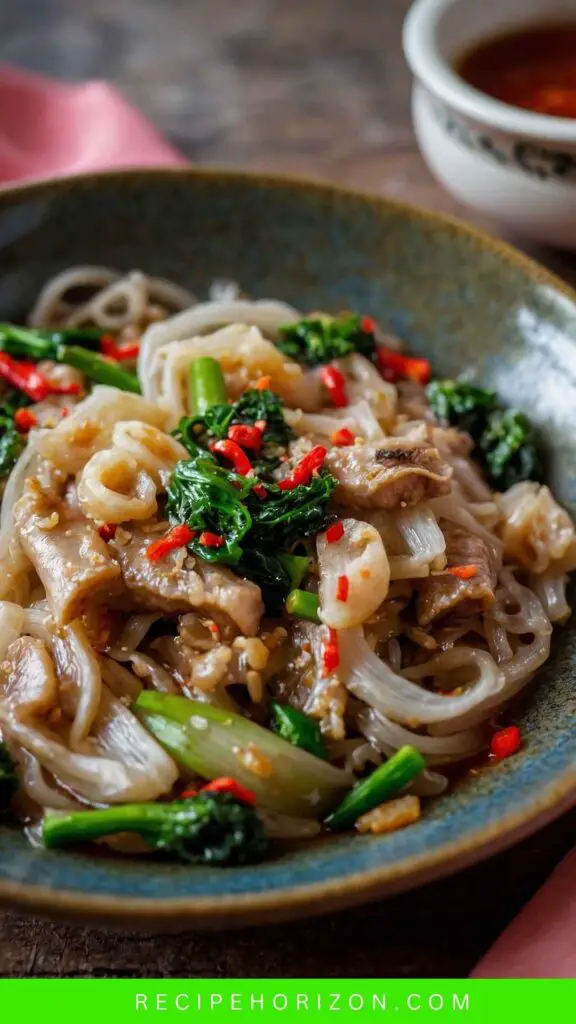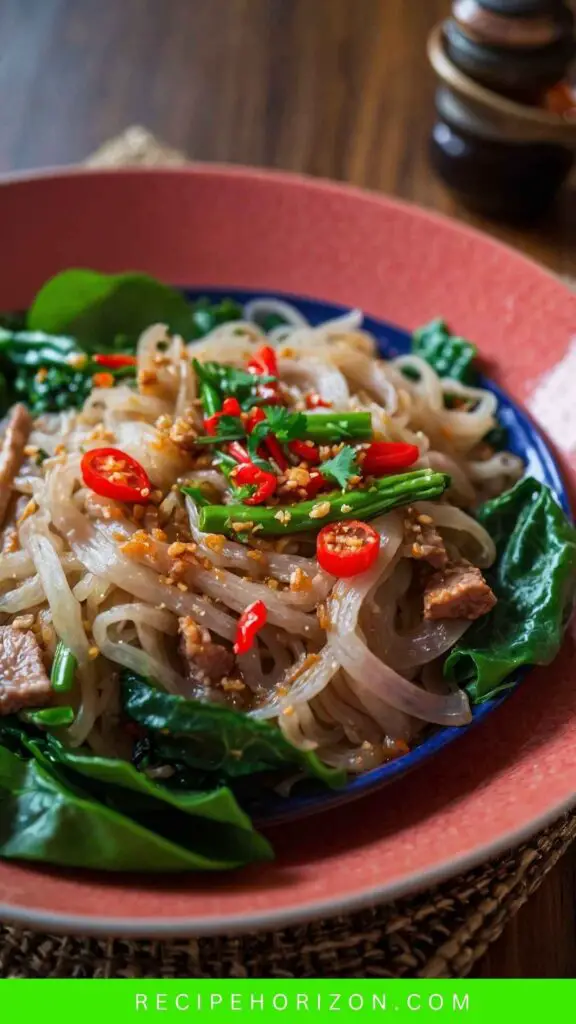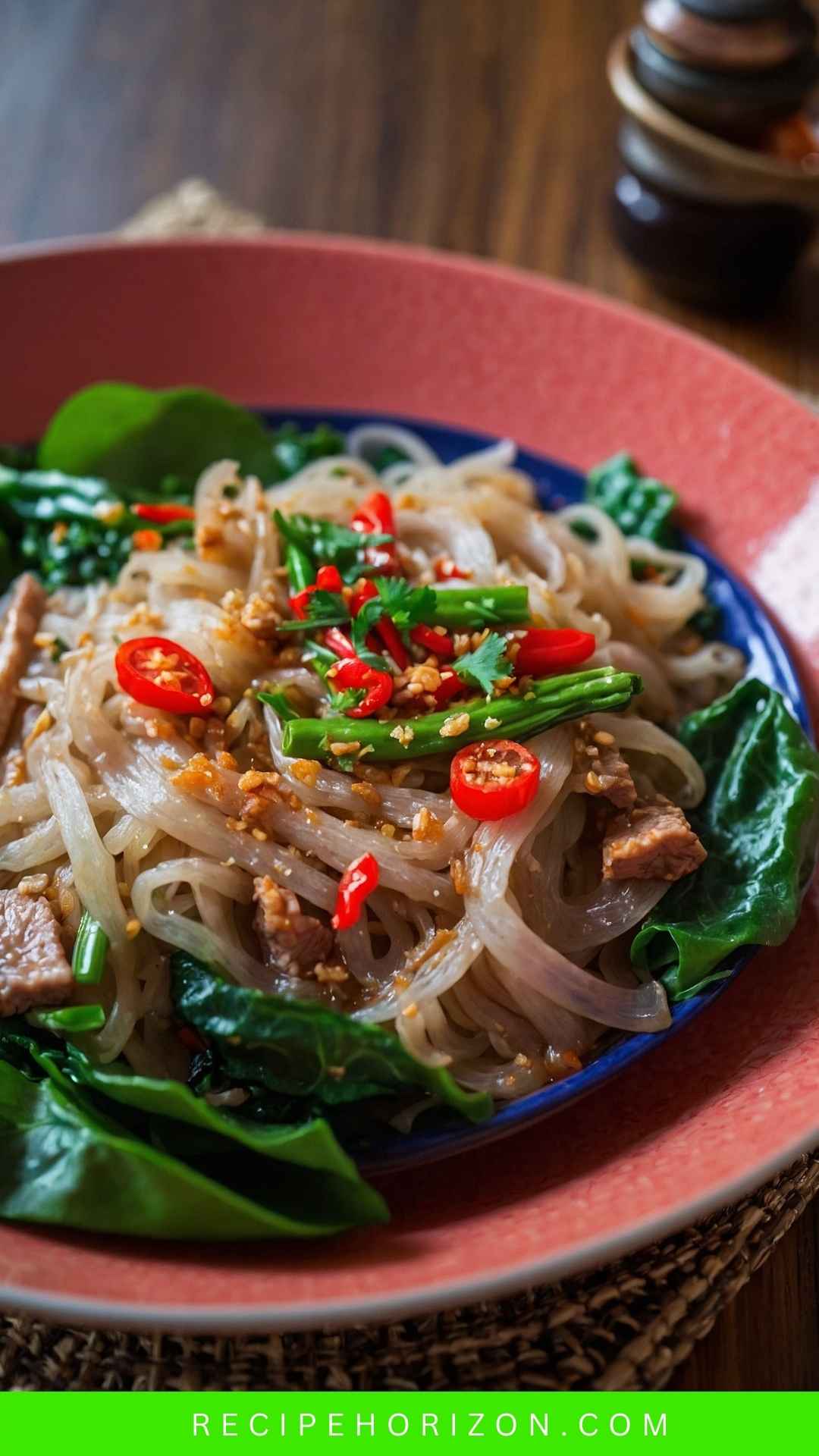Before we delve into the captivating world of Rad Na Thai noodles, let’s chat about what pairs well with this delicious dish. The hearty texture and savory flavor of this dish work wonders alongside a refreshing Thai salad. A cucumber salad with a hint of lime and chili balances the richness. Additionally, consider serving it with crispy spring rolls or grilled satay skewers. These pairings offer an enjoyable contrast, creating a meal that’s rich in flavors and textures.

You’ll Also Like These Recipes
- Thin And Crispy Gluten Free Crispy Pizza Crust
- What to Pair with Simplest Slow Cooker Black Beans at Home
- Raw Asparagus Salad with Walnuts and Parmesan Recipe
If you’ve ever strolled through a bustling Thai market or dined at an authentic Thai restaurant, you may have encountered Rad Na. It’s an intriguing dish, combining silky rice noodles drenched in a delectable gravy. As a passionate food enthusiast, my journey with Rad Na Thai noodles started several years ago, during my first trip to Thailand. I recall savoring a bowl from a street vendor, the experience forever etched in my taste buds.
In this post, I’ll take you through the ins and outs of Rad Na, covering everything from its origins to how you can recreate this delicious dish in your own kitchen. So, grab your chopsticks, and let’s get started!
What Are Rad Na Thai Noodles?
Rad Na, often called “stir-fried wide noodles,” consists of fresh wide rice noodles topped with a rich, flavorful gravy, usually made from a combination of pork stock, garlic, soy sauce, and fermented soybean paste. Originating from Thailand, it’s a favorite among locals and tourists alike. The dish is often enriched with tender meats, typically marinated pork or chicken, and seasoned vegetables like Chinese broccoli.
What sets Rad Na apart from other noodle dishes lies in its unique texture and sauce. The wide rice noodles offer a chewiness that complements the silky gravy beautifully. Every bite tells a story of tradition, flavor, and comfort.
What Makes This Recipe Different from Other Rad Na Thai Noodles?
One might wonder how my version stacks up against traditional recipes you find online. Here’s where my experience comes into play. My method incorporates freshly made ingredients, minimal MSG, and a few secret techniques I’ve learned along the way.
For instance, while many recipes rely on store-bought sauces, I advocate making them from scratch—like the gravy. Fresh garlic and homemade pork stock are game changers in this dish, producing a depth of flavor that store-bought versions simply can’t match. I also use locally sourced vegetables to ensure the freshest taste possible.
How Does It Taste?
Imagine a dish where savory meets umami, with a delightful chewiness from the rice noodles. Rad Na offers a balanced experience—it’s rich and flavorful, yet light enough to make you crave a second helping.
The pork stock’s sweetness and the depth of the fermented soybean paste create an exquisite dance of flavors on your palate. If you like your food with a little kick, don’t hesitate to add chili flakes. You’ll find the heat complements the dish exceptionally well.
Ingredients You’ll Need to Make This Dish
For the Marinated Pork:
12 oz pork shoulder (cut into bite-sized pieces, about ⅛” thick)
1 teaspoon rice wine or sherry
1 tablespoon light soy sauce
1 tablespoon oyster sauce
½ teaspoon granulated sugar
¼ teaspoon ground white pepper
1 teaspoon toasted sesame oil
2 tablespoons tapioca starch or cornstarch
1 large egg white
For the Noodles:
25 oz fresh wide rice noodles
1 tablespoon neutral oil
1 teaspoon dark soy sauce or black soy sauce
1 teaspoon toasted sesame seeds
For the Gravy:
2 tablespoons neutral oil
6 cloves garlic, finely chopped
3 tablespoons Thai fermented soybean paste (tao jiew) or low-sodium miso
3 cups unsalted pork stock (homemade is best)
1½ tablespoons soy sauce
1 tablespoon Golden Mountain Sauce (or substitute with Maggi seasoning or oyster sauce)
1½ tablespoons granulated sugar
1 teaspoon toasted sesame oil
½ teaspoon ground white pepper
7 oz Chinese broccoli (gai lan), stems sliced, leaves roughly chopped
¼ cup tapioca starch
¼ cup water
Condiments (optional):
Chili vinegar (highly recommended)
Roasted chili flakes

Step by Step Instructions
Step 1: Marinate the Pork
Begin by placing your bite-sized pork pieces in a mixing bowl. Add rice wine, light soy sauce, oyster sauce, sugar, ground white pepper, and toasted sesame oil. Mix well to ensure every piece is coated. Let it marinate for at least 30 minutes to deepen the flavor.
Step 2: Prepare the Noodles
If using fresh rice noodles, soften them in hot water according to the package instructions. Drain and set aside. If you have dry noodles, cook according to instructions, then rinse under cold water to prevent sticking.
Step 3: Cook the Pork
In a large skillet or wok, heat neutral oil over medium heat. Add the marinated pork, stirring occasionally until it’s golden brown and cooked through. This usually takes about 5-7 minutes. Remove from the skillet and set aside.
Step 4: Make the Gravy
In the same skillet, add more neutral oil if necessary, then sauté the garlic until fragrant. Stir in the fermented soybean paste and cook for a minute. Gradually add pork stock and bring it to a simmer.
Step 5: Thicken the Gravy
Mix the tapioca starch with water to create a slurry. Pour this into the gravy while stirring vigorously. Allow it to thicken and reduce slightly. Add soy sauce, Golden Mountain Sauce, sugar, ground white pepper, and Chinese broccoli. Stir until the broccoli is slightly tender.
Step 6: Combine Noodles and Sauce
Once the gravy is thickened, reduce heat. Return the cooked pork to the skillet and add the prepared rice noodles. Gently toss everything together, ensuring the noodles are coated in the gravy.
Step 7: Final Touches
Serve your Rad Na topped with toasted sesame seeds and optional condiments, such as chili vinegar or roasted chili flakes for that extra kick.
Tips & Tricks on Making Rad Na Thai Noodles
Use Fresh Ingredients: Fresh wide rice noodles are key. If you can find them, your dish will benefit from their unique texture.
Marinate Longer: For a deeper flavor, allow the pork to marinate for several hours or overnight.
Balance Your Sauce: Always taste as you go. Adjust soy sauce and sugar according to your preference.
Cook in Batches: If you’re making a large portion, consider cooking the pork and noodles in batches to avoid steaming them.
Experiment with Vegetables: Feel free to add bell peppers, carrots, or bok choy for extra color and nutrition.
Nutrition Information
A serving of Rad Na with pork offers a delightful balance of carbohydrates, protein, and fats. On average, one serving contains:
Calories: 450
Protein: 22g
Fat: 18g
Carbohydrates: 55g
Fiber: 3g
These values may vary based on the ingredients used. Adjust your portion sizes based on dietary needs.
How Do I Store This Dish?
To keep your Rad Na fresh, cool it completely before transferring it to an airtight container. Refrigerate for up to three days. When reheating, add a splash of water or stock to restore the sauce’s consistency.

What Other Substitutes Can You Use in Rad Na Noodles?
Chicken: If you have chicken on hand, swap it in place of pork for a lighter protein source.
Tofu: Vegetarian? Tofu makes an excellent substitute—choose firm tofu for the best texture.
Vegetable Stock: In lieu of pork stock, vegetable stock provides a flavorful base for the gravy.
Sweet Potato Noodles: If you’re looking for a gluten-free alternative, sweet potato noodles (or glass noodles) work well.
Broccoli Rabe: If Chinese broccoli is hard to find, broccoli rabe can stand in, offering a similar bitterness and texture.

Rad Na Thai Noodles
Ingredients
Equipment
Method
- Begin by placing your bite-sized pork pieces in a mixing bowl. Add rice wine, light soy sauce, oyster sauce, sugar, ground white pepper, and toasted sesame oil. Mix well to ensure every piece is coated. Let it marinate for at least 30 minutes to deepen the flavor.
- If using fresh rice noodles, soften them in hot water according to the package instructions. Drain and set aside. If you have dry noodles, cook according to instructions, then rinse under cold water to prevent sticking.
- In a large skillet or wok, heat neutral oil over medium heat. Add the marinated pork, stirring occasionally until it’s golden brown and cooked through. This usually takes about 5-7 minutes. Remove from the skillet and set aside.
- In the same skillet, add more neutral oil if necessary, then sauté the garlic until fragrant. Stir in the fermented soybean paste and cook for a minute. Gradually add pork stock and bring it to a simmer.
- Mix the tapioca starch with water to create a slurry. Pour this into the gravy while stirring vigorously. Allow it to thicken and reduce slightly. Add soy sauce, Golden Mountain Sauce, sugar, ground white pepper, and Chinese broccoli. Stir until the broccoli is slightly tender.
- Once the gravy is thickened, reduce heat. Return the cooked pork to the skillet and add the prepared rice noodles. Gently toss everything together, ensuring the noodles are coated in the gravy.
- Serve your Rad Na topped with toasted sesame seeds and optional condiments, such as chili vinegar or roasted chili flakes for that extra kick.
Nutrition
Notes
Marinate Longer: For a deeper flavor, allow the pork to marinate for several hours or overnight.
Balance Your Sauce: Always taste as you go. Adjust soy sauce and sugar according to your preference.
Cook in Batches: If you’re making a large portion, consider cooking the pork and noodles in batches to avoid steaming them.
Experiment with Vegetables: Feel free to add bell peppers, carrots, or bok choy for extra color and nutrition.
Tried this recipe?
Let us know how it was!Frequently Asked Questions
1. Can I make Rad Na ahead of time?
Absolutely! You can prepare the pork and noodles in advance. Just store the pork mixture separately and combine it with the noodles and gravy when ready to serve.
2. Is Rad Na suitable for kids?
Yes! Rad Na can be kid-friendly. Just moderate the amount of chili vinegar and roasted chili flakes added.
3. How spicy is Rad Na traditionally?
It typically depends on personal preference. You can adjust the spice level to your liking, starting with none, then adding chili flakes or sauce.
4. What’s the best way to reheat leftovers?
Reheat in a non-stick skillet over low heat, adding a bit of water or stock to prevent sticking and ensure a smooth gravy.
5. Can I use store-bought noodles?
Yes, if fresh rice noodles aren’t available, dry rice noodles can be used. Just follow package instructions for the best results.
Conclusion
Rad Na Thai Noodles are more than just a dish; they tell a story of culture, tradition, and flavors that bring people together. After trying this recipe, I hope you feel inspired to create your version at home. Each step is an adventure, leading to a satisfying meal that could quickly become a favorite in your household.
So, whether it’s your first time making it or you’re a seasoned pro, enjoy every moment in the kitchen. Happy cooking!




